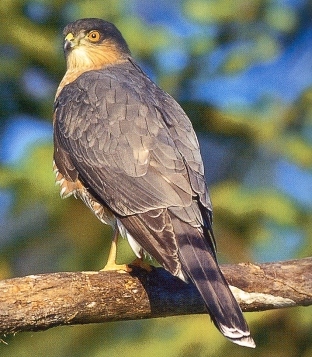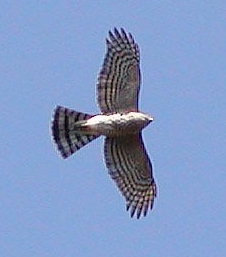|
Small hawk with blue-gray upperparts and rufous bars
on white underparts. Eyes are dark red. Wings are short and rounded.
Tail is long and squared with heavy bars. Legs and feet are yellow.
Flight consists of rapid wing beats followed by a short glide.
Often soars on thermals.
The adult Sharp-shinned Hawk has blue-gray upperparts and rufous bars
on white underparts. The eyes are dark red. Legs and feet are yellow.

|
SHARP-SHINNED
HAWK
Accipiter striatus
FALCONIFORMES
Kites, Eagles and Hawks (Accipitridae)
Range and Habitat
Sharp-shinned Hawk: Breeds throughout the U.S. as far north as Canada.
Spends winters from northern U.S. to Argentina. Found in deciduous,
coniferous, or mixed forests.
SOUND: "kik-kik-kik"
Adult Sharp-shinned Hawks pass food to their young in mid-air. They
will hover briefly and kick the prey outward
just as the fledgling arrives.
Large numbers are seen during migration. Over 11,000 were seen on one
October day at Cape May Point, New Jersey.
Their common name comes from the very thin, exposed lower leg of this
hawk.
A group of hawks has many collective nouns, including a "boil",
"knot", "spiraling", "stream", and "tower"
of hawks.
The Sharp-shinned Hawk has a large range, estimated globally at 20,600,000
kilometers. Native to the Americas and nearby island nations, this bird
prefers forest, savanna, and shrubland ecosystems. The global population
of this bird has not been precisely determined but does not show signs
of decline that would necessitate inclusion on the IUCN Red List.
 _______ _______
|